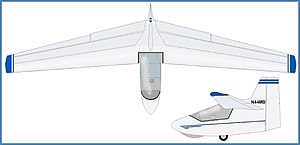Haig minibat
| Haig minibat | |
|---|---|

|
|
| Type: | Glider |
| Design country: | |
| Manufacturer: |
Amateur construction |
| First flight: |
1979 |
| Number of pieces: |
10-18 |
The Haig Minibat is a glider from the US amateur aircraft manufacturer Larry Haig. It is entirely in the tradition of the American miniature yachts for amateur construction. The objective was to outperform the practice sailor Schweizer 1-26 , which is widely used in the USA . In addition, it should be possible to build the machine in an American standard double garage, such as the older Backstrom EPB-1 .
construction
The tiny bat has a wingspan of 7.62 m, the curb weight is about 46 kg and the payload is 100 kg. The wing was equipped with a high-lift S-flapping profile from A. Liebeck. The profile has a round nose and a large curvature, which leads to a concave underside of the wing. The airfoil, which was one of the first to be developed using computer programs, turned out to be the main reason for the aircraft's failure.
The Minibat is made of an ultra-light fiber composite construction. It is controlled via separate elevators and ailerons as well as a central rudder. The “Minibat” can be flown between 60 and 200 km / h and has a glide ratio of 23. The wingspan can optionally be increased to 10 m by means of attachable surfaces, which improves the glide ratio to 30. Optionally, a small section between the inner and outer wing flaps is provided as a spreading brake flap, but the machine is normally built without landing aids. The kit consisted only of 18 molded GRP parts and a set of fittings.
It was also planned to install a 6 kW chainsaw motor, which was supposed to drive a small propeller between the fin and the rudder. With this auxiliary drive, the machine was not capable of self-starting, but was able to maintain its altitude.
Although this small ship achieved the expected performance (like the German Ka-8 ), but since the Minibat had difficult take-off and landing properties, it was not a success. Only about 50 kits were sold and registration numbers were assigned to 18 machines. Ten of them were still registered in 2011. In March 1981 the illustrated N44MB graced the cover of Soaring Magazine . Overall, however, only a few minibats were completed, four of which crashed in start-up accidents. Larry Haig then stopped working as a designer of modular aircraft.
Technical specifications
| Parameter | Data (with clip-on wings) |
|---|---|
| crew | 1 |
| length | 2.84 m |
| span | 10 m |
| height | |
| Wing area | 7.11 m |
| Wing extension | 14th |
| Glide ratio | 30th |
| Slightest sinking | 0.91 m / s |
| Payload | 100 kg |
| Empty mass | 59 kg |
| Wing loading | 22.4 kg / m² |
literature
- Rudolf Storck among others: Flying Wings . The historical development of the world's tailless and flying wing aircraft. Bernard and Graefe, Bonn 2003, ISBN 3-7637-6242-6 .
- Bob Said: 1983 Sailplane Directory, Soaring Magazine, p. 122. Soaring Society of America, November 1983. USPS 499-920